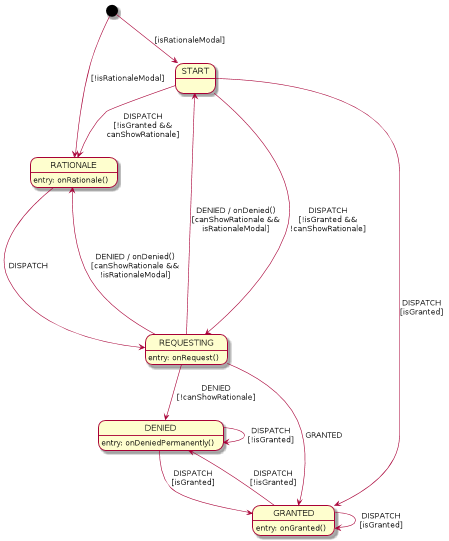EzPermission
Go straight to Changelog.
Handling dynamic permissions on Android is a major PITA, mainly due to the braindead API design.
This library is yet another helper that makes permission handling easier.
It's based on state machine that handles the user flow. Pass a code that requires a permission as a callback and invoke it via EzPermission.call() helper. The helper will handle permission flow and call intended code when permission is available.
Features
- single-file implementation, if you want to pull it inside your project
- based on state machine, so fixing corner cases should be very easy
- modal rationale (using dialog)
- modeless rationale (being integrated into screen itself)
- focused on permission handling logic - doesn't contain any UI code
- handles permissions revoked at runtime via settings menu
- handles permissions granted at runtime via settings menu
Limitations
This library is focused on permission handling logic and it doesn't contain any UI code.
Versioning scheme
MAJOR . FEATURE . BUGFIX
MAJOR- hardwired to 1, as usual in software versioning :)FEATURE- increased for new featuresBUGFIX- increased for bugfixes only
Integration
Dependencies
Add my private bintray repository in your root build.gradle:
allprojects {
repositories {
...
maven {
url "https://dl.bintray.com/ezaquarii/android"
}
}
}
In module build.gradle, add a dependency:
compile ('com.ezaquarii:ezpermission:1.2.0') {
exclude group: 'com.android.support'
}
Modeless
Modeless flow is useful in situations, when we can't construct the screen UI without proper permission. A canonical example of such case is a camera application, where camera preview occupies full screen.
class MainActivity : AppCompatActivity() {
companion object {
@JvmField val REQUEST_CAMERA_PERMISSION = 1000;
}
private val mInitCamera = EzPermission.of(this, REQUEST_CAMERA_PERMISSION, arrayOf(Manifest.permission.CAMERA, Manifest.permission.WRITE_EXTERNAL_STORAGE))
.onGranted{
onCameraGranted()
}
.onRationale{
onCameraRationale()
}
.onDenied{
onCameraDenied()
}
.onDeniedPermanantly{
onCameraDeniedPermanently()
}
.build()
override fun onStart() {
super.onStart()
mInitCamera.call();
}
...
}
Modal
Modal flow is probably the most popular one. Permission rationale is shown as a dialog (or similar UI widget), that breaks the user flow. Once user accepts the rationale, we launch permission query again.
With EzPermission this is... well... easy.
class MainActivity : AppCompatActivity() {
companion object {
@JvmField val REQUEST_AUDIO_PERMISSION = 2000;
}
private val mRecordAudio = EzPermission.of(this, REQUEST_AUDIO_PERMISSION, arrayOf(Manifest.permission.RECORD_AUDIO, Manifest.permission.WRITE_EXTERNAL_STORAGE))
.onGranted{
onAudioGranted()
}
.onRationale{
onAudioRationale()
}
.onDenied{
onAudioPermissionDenied()
}
.onDeniedPermanantly{
onAudioPermissionDeniedPermanently()
}
.build()
// on click handler, attached to some "record" button
fun onClickedRecordAudio(v: View) {
mRecordAudio.call()
}
// called when permission to use microphone is obtained
private fun onAudioGranted() {
toast("Recording audio")
}
...
}
What are those callbacks?
Callbacks provided to EzPermission are being invoked by the state machine at appropriate moment. You should consult provided sample to see how to use those callbacks to implement UI changes (reveal rationale, launch alerts, etc).
Credits
- PlantUml folks, for excelent, pragmatic UML tool. Your stuff rocks
- The Apache Software Foundation for Apache 2.0 Licence
- CryoChamber for background noise
Licence
Copyright (C) 2017 EzPermission by Krzysztof Narkiewicz ([email protected]) Licensed under the Apache License, Version 2.0 (the "License");
you may not use this file except in compliance with the License. You may obtain a copy of the License at http://www.apache.org/licenses/LICENSE-2.0 Unless required by applicable law or agreed to in writing, software distributed under the License is distributed on an "AS IS" BASIS, WITHOUT WARRANTIES OR CONDITIONS OF ANY KIND, either express or implied. See the License for the specific language governing permissions and limitations under the License. 